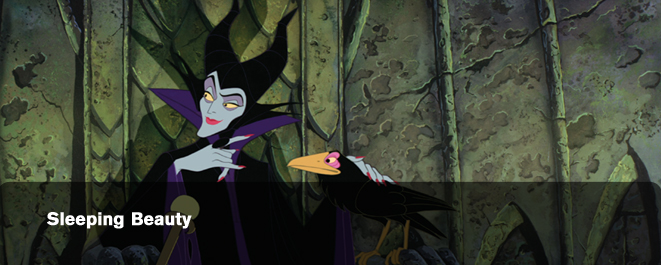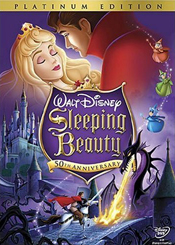 |
|
|

Disney has done
a respectable job over the years with their classics
being restored and released on DVD. With few exceptions,
they've gone in and let the films retain their original
colors, beauty, film grain and luster. Although it is
true that Disney, like many studios, has remixed
original mono soundtracks into 5.1 surround sound,
they've at least done the "right thing" and put the
original mono soundtrack option on the DVD. Disney has
done some overly digitized clean-up on "Snow White and
the Seven Dwarfs" and "Cinderella," which left those
films with an unnatural and sterile appearance. Overall,
they've been pretty consistent in letting the films
maintain their original "flaws." A speck of grain or a
speck of dust never turned off an audience from enjoying
a Disney classic.
"Sleeping Beauty" is again available on DVD
and Blu-ray. This review is on the DVD.
"Sleeping Beauty" has been a perennial classic in the
Disney line up for many years after its original release
in 1959. Not as much adored by audiences as some of
Disney's other fairy tales with warmer lead characters
and heart, "Sleeping Beauty" is nonetheless an
entertaining and visually breathtaking film. It was a
box office disappointment in 1959, but through
re-releases in theaters up until 1986, and then video
and occasional revival screenings during the 1990s and
2000s, the film has made money. It's now regarded by
many animation and film historians as a breathtaking
achievement, which is positive criticism that the film
didn't really receive in 1959.
When the film was restored beautifully in 1996, a 70mm
print was struck and it was one of the most gorgeous
films these eyes have ever seen. That particular
restoration was painstakingly accurate. The image
quality was in-line with the Technirama process in which
it was shot in. The sharpness, the depth of the image,
the color, the aspect ratio for the 70mm print was
lovingly rendered by the restoration team headed by
Harrison Ellenshaw. It was, in my opinion, the correct
way to do a restoration. The film wasn't tweaked to
today's "modern thinking" or "If Walt had this digital
technology, this is what he would've done!" No. It was
done with today's technology (Kodak's Cinesite) with
respect for the original artists and their intent.
So why on Earth would Disney decide to re-restore "Sleeping Beauty," and in the process,
screw up its original composition and soundtrack? Wasn't
the 1996 restoration perfect? I thought it was.
Beauty Over The Years
It's a overused term, but there's no other term I can
think of when it comes to this 2008 restoration. If it ain't
broke, don't fix it. The restoration team behind this
new "enhanced" and "like you've never seen it before"
version took it upon themselves to re-compose how the
film was originally shot. They tinkered with the colors
of the film (which is very noticeable in the opening
title). The team re-mixed the soundtrack and it doesn't
sound as good as it did in the 1996 restoration. In the
most simplest terms for non-geeky people, this 50th
anniversary version of "Sleeping Beauty" isn't the
version that's been seen (if shown properly) for almost
50 years.
Please understand that I've admired most of
the work that the current Disney restoration team has
done in the past. Most of their work has kept the
natural beauty of films like "Lady and the Tramp" honest
and true. But this "Sleeping Beauty" restoration has me stumped. I've
loved this film since I saw it for the first time during
a re-release in 1986, and to see it restored in any
other way than its original form is wrong.
The film has either been shown in a 2.35:1 aspect ratio
on 35mm prints (and I believe early versions of the film
on LaserDisc.) The way the film was originally meant to
be shown, and advertised, was in 70mm with a 2.21:1
aspect ratio. It was advertised as "Super Technirama
70." It was never meant for the ultra-wide 2.55:1 aspect
ratio that is used in its current "restoration." The
2.55:1 aspect ratio was used for CinemaScope, which
predated Technirama. CinemaScope used that aspect ratio
for a few years since its official public unveiling on
1953's "The Robe." CinemaScope went to the 2.35:1 aspect
ratio around 1955. Technirama was unveiled in 1956 with
a 2.35:1 aspect ratio on 35mm prints, which I would
imagine matched the then current aspect ratio for most
35mm widescreen movies made in CinemaScope. On 70mm
prints, as mentioned earlier, the aspect ratio was
2.21:1, and "Super Technirama 70" was first used on Walt
Disney's "Sleeping Beauty" in 1959. Technirama never had
a 2.55:1 aspect ratio that I'm aware of. The widest
aspect ratio a film could be shot in Technirama was
2.25:1. I invite readers to click
http://www.widescreenmuseum.com/widescreen/lobby.htm
to check out the various film formats. It's easy to
understand and Martin Hart has done a wonderful job in
explaining formats. I also recommend his other page on
aspect ratios,
http://www.widescreenmuseum.com/widescreen/cinemascope_oar.htm.
I don't know how much more simpler understanding aspect
ratios can be.
For all of its story weaknesses and a lack of heart,
"Sleeping Beauty" is truly one of the most visually
impressive films from the 1950s. This is a film that
needs to be seen on the big screen in 70mm to really
appreciate its beautiful animation and backgrounds.
This is a detailed and multi-dimensional looking film on
the big screen. No video format will
give a viewer the same impression. The visual
composition and staging of the film was brilliantly used
in the Technirama format. The action flows across the
screen with ease. The beauty of Technirama, especially
in the Super Technirama 70 prints, was that the frame
(aspect ratio) was still wide, but pleasing to the eye.
In addition, the restored 70mm print from 1996 had great
color and depth that I'd never seen before in this film.
In 2003, Disney released "Sleeping Beauty" on DVD,
proclaiming that it looked better than it did in
theaters. I laughed, because the movie looks better on a
big screen. Nonetheless, Disney did an impressive job on
that DVD release. By the looks of it, they used the 1996
restoration's visual and sound elements and used the
2.21:1 aspect ratio that would've been seen on 70mm
prints. Picture and sound quality were very good for
DVD. My only complaint at the time was that Disney also
included a pan-and-scan version of the film.
Restoration - Let's Try It
Our Way
For the 2008 re-issue, the restoration team decided to
"reveal" more of the artwork that was supposedly
available during the production of "Sleeping Beauty."
Apparently there was a bit of extra space around the
original backgrounds that wasn't used during the
production. They've essentially re-shot the film to
reflect a super wide CinemaScope aspect ratio, which had
nothing to do with the production's use of Technirama.
From what I understand, by 1955 most films shot in
CinemaScope were framed for 2.35:1. Technirama, in which
"Sleeping Beauty" was filmed, wasn't around in 1955. It
is true that Disney originally was going to shoot the
film in CinemaScope, but at some point in time during
its long production history, it was decided to go with a
more elaborate and ultimately sharper image quality by
using the Technirama format. Roadshow presentations, in
which movies were usually filmed in a big film format
and presented in select theatres, were big in the 1950s.
Disney probably felt it was necessary to capitalize on
that craze, and what better film than "Sleeping Beauty"
to show off a new film format like Super Technirama 70?
It was Disney's second animated feature foray into the
widescreen format after "Lady and the Tramp" (1955).
"Lady" movie was filmed in CinemaScope and apparently was
composed and shot in the 2.55:1 aspect ratio. "Sleeping
Beauty" was not shot in that format or aspect ratio, so
why would the restoration team backtrack to a film
format that wasn't going to be used on it anyway? The
result of this new thinking has changed how the original
film feels on an emotional level. The framing of
"Sleeping Beauty" is different. The staging is now
different. The film feels claustrophobic. The action doesn't "breathe" on the
screen. The characters seem like they're trapped in a
letterbox and can't get out.
The soundtrack has been re-worked for 7.1 surround
sound. The original mix of "Sleeping Beauty" was never
sonically spectacular. The sound quality itself,
especially on the dialogue, was tinny and not very
dynamic. I'm not sure exactly when the original voice
recordings and sound effects were done, but they weren't
of the same caliber as Disney's other films of the era.
Disney's sound department was usually very good with
their sound mixes.
The 1996 restoration had a
three-channel mix, even though the 70mm prints could
contain six tracks of audio. Left, center and right
channels were used on that 1996 mix, and I'm positive
that mix followed the original recording's audio stems.
The 1996 sound mix was perfectly suited and respectful
to the original mix.
Disney has usually done a smash up job on their sound
mixes on the old classics. It's a bit odd that old films
like "Bambi" have surround sound, but at least Disney
has kept the original mono mix on the DVD as an option.
The original mix is available here, but I'm not fond of
the new remix. Oddly enough, the short "Grand Canyon" is
available on this DVD and it sounds better than
"Sleeping Beauty." Its soundstage and natural
stereophonic sound is warmer and more pleasing to listen
to.
The 2008 restoration takes a different track. Other than
the redundant use of 7.1 surround sound, the soundtrack
sounds like it's been remixed and/or re-equalized. The
sound quality, mostly on the dialogue and sound effects,
now sounds flat and uninvolving. It's as if the sound
was re-engineered to correct whatever flaws it had, and
now the sound is lifeless. If the original recording was
weak, there is no amount of digital tweaking that will
make it sound better.
An Underrated Classic
"Sleeping Beauty" isn't in the same league as some of
Disney's other classics like "Bambi," "Snow White and
the Seven Dwarfs," or "Cinderella." It is, though, a
fast paced and decently made film that like many of the
big widescreen epics of the 1950s, plays better on a big
screen.
The story revolves around Princess Aurora (Mary Costa)
and how the evil witch Maleficent (Eleanor Audley) has
cast a spell on her that can only be broken by love's
first kiss. Aurora is voiced and sung by Costa and she's
excellent in the role. Walt had a knack for picking
great voice talent. Unfortunately, Aurora is rather bland
as a character. As she's written, Aurora really doesn't
have a wish like other Disney princesses have. She
pretty much wanders around the forest singing songs and waits for her prince to come. The audience
doesn't care for her plight like they do with Snow White
or Cinderella. We don't feel a lot of danger when
Maleficent entices her to prick her finger on a spinning
wheel, nor do we really miss her when she's slumbering.
The strongest and most sympathetic characters are
Flora, Fauna & Merryweather.
The fairies add humor and warmth to the
film, where Aurora is rather cold. It's not to say she's
not appealing. She's beautifully drawn and animated and
her songs are memorable. She's just not very interesting
on the whole.
The strongest character in the film is Maleficent.
Animator Marc Davis did a splendid job on creating a
truly graceful and frightening figure. Her elegant
yellow eyes and purple and black clothes make for an
intriguing villain. She's voiced well by Eleanor Audley. Unlike Aurora, she's
hell-bent on
getting what she wants. Maleficent is an outcast in the
kingdom in which Aurora's parents rule and will stop at
nothing to keep the young princess in a deep, deep
sleep. Add a bit of jealously over the princess's
beauty, Maleficent is a downright cruel character. But
we love her anyway.
The story of Disney's "Sleeping Beauty" is disjointed
and isn't strong like many of its other fairy tales. I
wonder if the production took so long due to story
issues and the fact that the Disney studio was branching
out in the 1950s. This was an extraordinary growth
period in the company's history with Disneyland, the
Disney television shows, feature live action films,
animated features and shorts occurring at the same time.
The movie is still enjoyable. The decision to utilize
artist Eyvind Earle's magnificent detailed style adds so
much depth and detail to the frame. The entire
production uses a blend of Medieval artistic style and
late-50s modernistic design. Much of the film's look is
angular with sharp lines and the lack softness may have
turned off many of Disney's animation fans. But looking
at the film today, it's easy to admire the risks the
studio took.
The film has tested time. Disney used to re-release the
film in theaters and it's been very successful on home
video. This latest incarnation doesn't, in my opinion,
do the film proper justice. It's meant to be seen with
an aspect ratio 2.21:1 in 70mm. That's the way it was
intended to be seen and experienced.
Technical Technirama Note
As mentioned earlier, "Sleeping Beauty" was filmed in
Technirama. Walt Disney and his studio was always
looking for the next best technology to help tell its
stories. He embraced sound for his early cartoons, color
for many of his cartoons, stereophonic sound for
"Fantasia" (1940), the widescreen format of CinemaScope
for some cartoons and features, and Technirama for
"Sleeping Beauty." The
film would ultimately be shot in that format and
presented in 70mm prints. The Technirama format was
actually a very versatile method in which to shoot and
present a film. By using a larger negative than standard
35mm film, the original negative could look outstanding.
By printing 70mm prints, a film could not only use a
larger and brighter screen, but the 70mm print could add
prestige to a movie. Hence, the Super Technirama 70
moniker.
Technirama was one of the underrated film
processes of the 1950s. Technirama used 35mm film turned
horizontally, much like Paramount's VistaVision format.
Both formats used eight perforations of 35mm film, thus
creating a large negative to shoot. Almost any 35mm
you've seen would use film vertically and only four
perforations of film.
Technirama went a step further by
using an anamorphic lens. This lens would "squeeze" the
image, then another anamorphic lens on the projector in
a theater would un-squeeze the image into a widescreen
composition. With Technirama, Disney and other producers
could in turn have the lab print 70mm Six Track magnetic
stereophonic prints for special presentations. The
result was a sharp and bright image that standard 35mm
film couldn't achieve. Standard high quality 35mm prints
could also be struck for later engagements of a film for
smaller markets and/or wider release. For "Sleeping
Beauty," Disney was the first studio to go with the
"Super Technirama 70" logo and presentation. Other
studios would follow suit.
Bill Kallay
Special thanks to Click Communications
Photos: © BVHE. All rights reserved.
| DVD Quick Glimpse | |
|
|
 |
